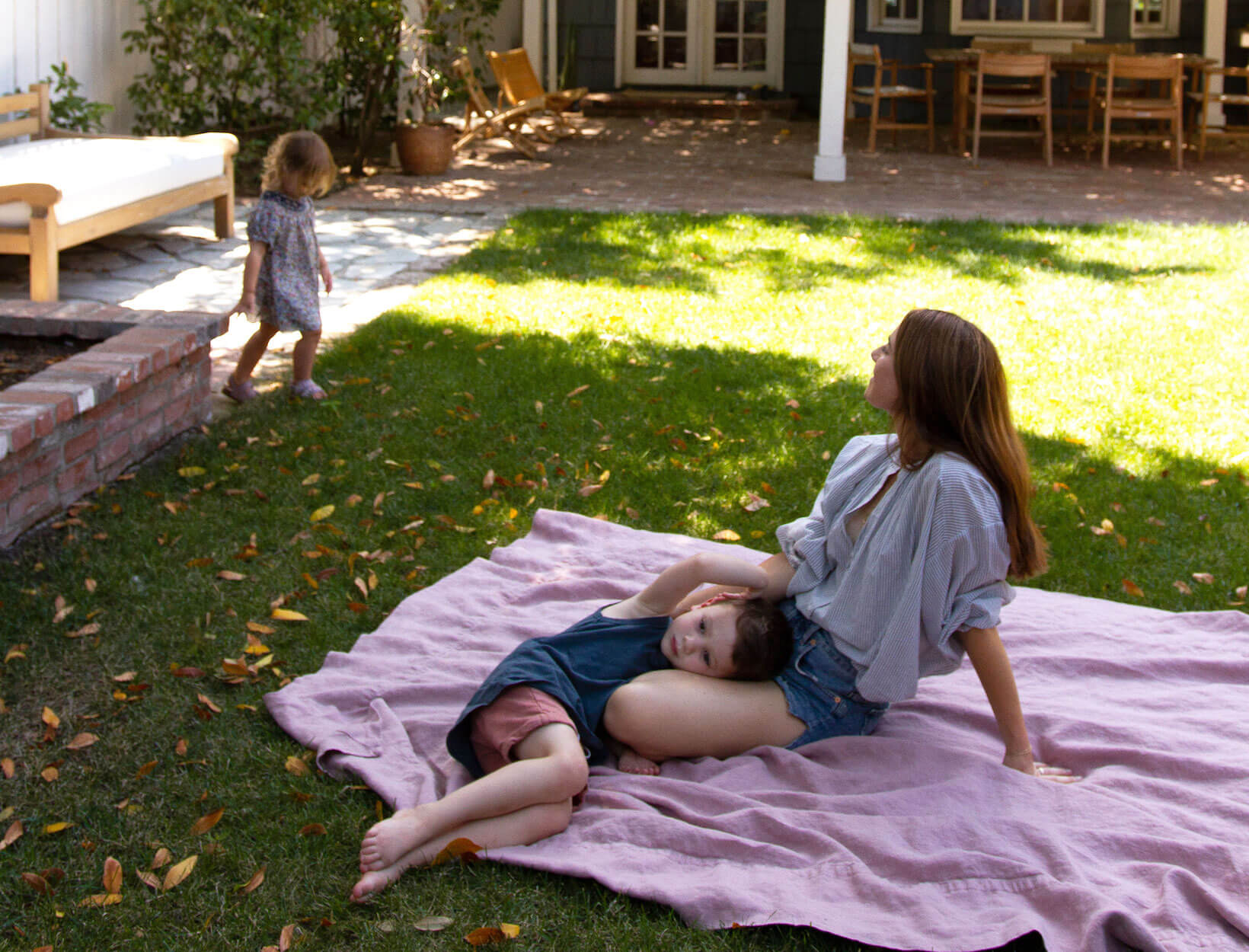[ad_1]

Photo courtesy of Alicia Lund
Helping Kids Manage Big Feelings

When psychotherapist Annie Armstrong Miyao works with children, she gets a peek into the untrained, reactive mind, where little discomforts are a huge deal and just about anything is worth getting upset over. In her practice, she helps kids learn to soften up bit by bit.
What works best, Armstrong Miyao offers, is a long-term approach toward emotional awareness and resilience. It starts with teaching kids to identify and talk about what they’re feeling and developing strategies they can reach for when they feel overwhelmed.
But teaching kids to regulate their emotions is slow work. Armstrong Miyao has three kids herself, and some days of tending to their tears and tempers go more smoothly than others. When she’s struggling to find ways to help, Armstrong Miyao falls back on the co-regulation techniques she teaches parents in her psychotherapy practice, which have just as much to do with parents’ own emotional reactivity as they do their children’s.
Helping Kids Increase Awareness around their Emotions
and Build Tools to Self-Regulate
My second-grade teacher didn’t like me. She reminded me of an angry owl—with a tight body, pinched face, and angry eyes that looked down at me from her desk perch. She would yell at me from across the room while I daydreamed out the window, and it wasn’t uncommon that someone else would do something and she’d use the opportunity to scold me. Like when my best friend tripped three rows of desks away: “See what happens when your shoes are not tied, Annie!”
It wasn’t long before I began to get stomachaches on the drive to school. My mother noticed, and she consulted with my wonderful pediatrician, who taught me little ways to meditate. When my belly started to churn, I learned to excuse myself to the nurse’s office and imagine I was a rag doll, floating on a cloud, slowly relaxing one part of my body after another until the stomachache receded or I drifted off to sleep.
While I never named the emotion that spurred the stomachaches—now I recognize it as dread or anxiety—it was understood and tended to by the adults in my life who cared for me.
For better or worse, children are present, literal, passionate, spongelike beings. They can swing from one big emotion to another. They are still developing the parts of their brains that help them understand cause and effect. If we, as adults, can lower our expectations of kids’ self-regulation skills—and remind ourselves that they don’t have the life experience to understand that the big feeling will pass—maybe we can move through their emotional weather fronts with more ease.
As a mother, I often feel overwhelmed by the tornadoes of emotion that descend from a too-tight sweatshirt, a banana peeled the wrong way, something unkind a friend said at school. I do my best to stay centered for my little brood, a port in the emotional storm.
A large part of my work is to help my clients identify, explore, and process strong feelings, in part by finding ways to self-regulate or self-soothe. So when I’m struggling to help my kids manage their emotions, I turn toward some basic tools I use in my clinical psychotherapy practice. The goal is not to eliminate our kids’ feelings or achieve some kind of eternal neutrality but to help them find ways to care for themselves when their feelings are overwhelming.
ACTIVITIES TO HELP KIDS LEARN TO MANAGE EMOTIONS
1. Identifying and Communicating Emotions
Learning to name our feelings helps us both better understand what we need and better communicate those needs with our loved ones. It can be helpful for kids to deepen their awareness of their feelings by identifying the sensations emotions create in their body. For younger kids, I draw a big gingerbread man on a sheet of paper to represent the child, name a feeling, then ask them to pick a color to represent that feeling and color on the gingerbread man where they feel it in their body. (I offer a list of five big classes of feelings: mad, glad, sad, afraid, or neutral.)
This is one way for them to learn about the unique way they process their experiences. Although they can’t always tell us, “I’m mad, and I want to hit something,” they might learn to recognize a cue their body gives them, like their head and hands get red-hot when they are mad. So the next time their head and hands get red-hot, it’s time to go find a pillow to punch (instead of hitting you or their sibling).
In the grip of a big emotion, children often feel out of control. When they are in the heat of the moment, try to name what you are seeing: “You are so mad; I see you.” I make a point to help kids identify when they feel good, calm, excited, joyful, and grateful, too. I try to keep a one-to-one ratio: For every difficult emotion you find together, identify a pleasant one, too.
2. Exploring Emotions
The more children understand their emotions, the easier it is for them to move through life feeling them. The next activities are about building objectivity and deepening awareness around emotions.
This activity asks your child to illustrate in their own way what an emotion feels like: I draw a grid of eight squares on some paper, pass it off to the child with some markers, name a feeling, and ask them to draw an image that reflects that feeling in one square. Then we move on to the next feeling. Have your own piece of paper to draw on, too, so when you’ve filled in all eight squares you can share with each other what your feelings look like.
The next one is a mindfulness practice to help kids learn impermanence. I invite the child to find a metaphor that makes sense to them to remind them that feelings come and go. Maybe: “My anger is like a big wave. It crashes down, then it rolls back out to sea.” We draw pictures of different emotion waves, we talk about what to do when a big wave of anger comes, and so on. This can help them learn to tolerate feelings as they come and go, trusting that they aren’t going to get stuck in any feeling forever.
Because we’re working with kids, these activities typically work best when they look like play. So use your imagination: Have them imagine they are a detective reporting back to you on their anger. When does it come? How do they know their anger has gone? Or ask them to write a story where their joy is the main character. One magical child and I made a whole comic book together, in which each emotion was a superhero who would use their powers to help solve the biggest challenge about being that emotion.
3. Processing Emotions as They Come Up
Sometimes our kids need us to just listen to them. Sometimes they need help solving a problem. And sometimes they need containment so they can feel the emotion until it goes away.
Here’s the formula I use to talk to kids when they’re in the heat of a big feeling. How exactly you go about it will depend on the situation, the age of the child, and what you’ve already found works or doesn’t work for them.
1. Validate their emotions. Acknowledge what they’re feeling and why: “I know you’re so upset because you wanted a turn to play with the broom.”
2. Give them some perspective and grounding. You can do this by saying something like, “I know now you feel like the whole day is ruined. I get it. I also know that there is good stuff ahead, and I don’t want you to get stuck in this mood and miss out.”
3. Share a plan to help them contain the feeling or move through it without shaming them or stifling the feeling. You could try something like, “Here’s the plan: I am going to let you be to have all the feelings, and I’m going to set a timer for ____ minutes. Then we are going to shake off this mood.”
4. Follow through. If your plan was to shake off the mood when the timer dings, literally shake it off with them—move your bodies to help let the emotion move.
If you have a little chronic worrier, consider giving them a specific time in the day to do their worrying. Remind them that if their worry comes up throughout the day they can tell themselves, “Now is not the time to worry about this; I will worry about it at four o’clock.” When four o’clock comes, give them your attention if they want to vent about their worries, or maybe they want to journal or draw about them. Be consistent, listen, and check in at the end of the time to see how they feel. You can start by asking if they feel better, worse, or the same.
When the child has recentered after whatever big emotion you’re working with, help them notice that something has changed. Encourage them to be curious about what made a difference. For older kids: “Are you feeling sad anymore? What do you think shifted?” For younger kids, you can reflect what you see. It doesn’t need to be a big to-do, just a simple “I noticed that you aren’t upset anymore. Did your body adjust to the new feeling of that sweatshirt?”
4. Self-Soothing and Co-Regulating
One of the best ways to teach self-regulation is to model it yourself. So: Take a break if you need to. Let the child know what you are doing: “I am overwhelmed and need a moment—I will be back in two minutes.” Learn about how you express feelings and how you tend to yourself when you feel overwhelmed by emotion. What was modeled for you? What has shaped your ideas about what is acceptable when it comes to expressing emotions?
As you fine-tune your own ability to self-regulate, so does your child. Co-regulation is the supportive process between caregiver and child in which the child finds safety, calm, and love within the relationship. It’s an ongoing process that takes place at various developmental stages. When our children find themselves in a space that is beyond their capacity, their mood, sense of security, and sense of calm can align with yours, just like they did when they were infants. They can reset with you both emotionally and physiologically. Hold them in your arms; take deep breaths in unison; imagine you are floating on a cloud as you lie together on the couch.
When the big feelings have entered next-level reactivity, teach them to focus on their senses. Get outside, listen for the birds, count the flowers on that bush, feel the dirt between your toes, take a bath, drink a glass of water, or put some cool water on their little face. I help my clients identify a place that is calm and safe. We practice envisioning it in our mind’s eye—what it looks, smells, feels, and sounds like—so they can visit it in their mind when they’re feeling overwhelmed.
Mostly, offer love. I love my kids in their struggle, and I love myself in my own. One of the primary goals of parenting is being a space that our children can return to as the storm passes.
Annie Armstrong Miyao is a Los Angeles–based psychotherapist, writer, and mother of three.
[ad_2]
Source link

